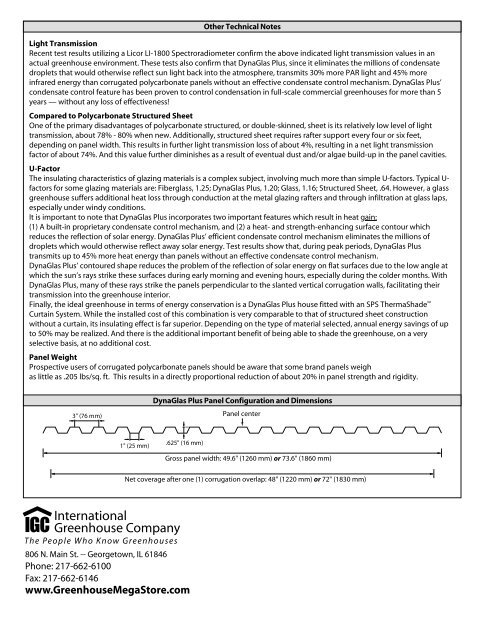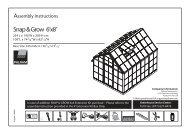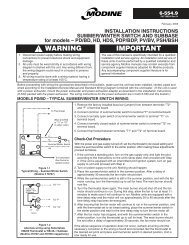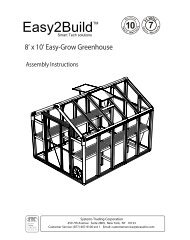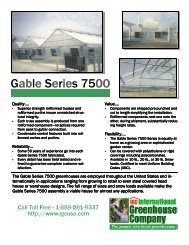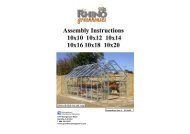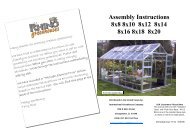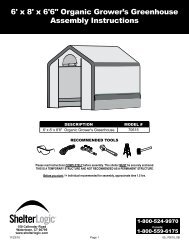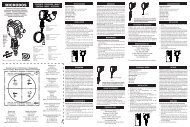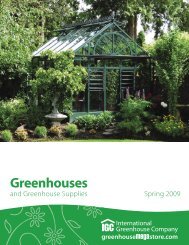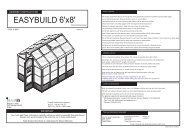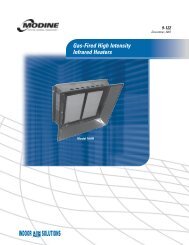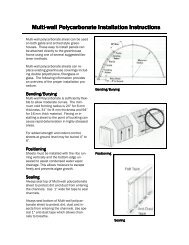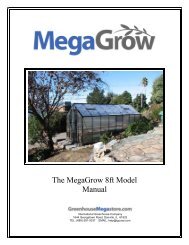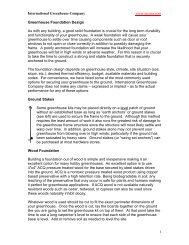DG Technical Information - International Greenhouse Company
DG Technical Information - International Greenhouse Company
DG Technical Information - International Greenhouse Company
Create successful ePaper yourself
Turn your PDF publications into a flip-book with our unique Google optimized e-Paper software.
Other <strong>Technical</strong> Notes<br />
Light Transmission<br />
Recent test results utilizing a Licor LI-1800 Spectroradiometer confirm the above indicated light transmission values in an<br />
actual greenhouse environment. These tests also confirm that DynaGlas Plus, since it eliminates the millions of condensate<br />
droplets that would otherwise reflect sun light back into the atmosphere, transmits 30% more PAR light and 45% more<br />
infrared energy than corrugated polycarbonate panels without an effective condensate control mechanism. DynaGlas Plus’<br />
condensate control feature has been proven to control condensation in full-scale commercial greenhouses for more than 5<br />
years — without any loss of effectiveness!<br />
Compared to Polycarbonate Structured Sheet<br />
One of the primary disadvantages of polycarbonate structured, or double-skinned, sheet is its relatively low level of light<br />
transmission, about 78% - 80% when new. Additionally, structured sheet requires rafter support every four or six feet,<br />
depending on panel width. This results in further light transmission loss of about 4%, resulting in a net light transmission<br />
factor of about 74%. And this value further diminishes as a result of eventual dust and/or algae build-up in the panel cavities.<br />
U-Factor<br />
The insulating characteristics of glazing materials is a complex subject, involving much more than simple U-factors. Typical U-<br />
factors for some glazing materials are: Fiberglass, 1.25; DynaGlas Plus, 1.20; Glass, 1.16; Structured Sheet, .64. However, a glass<br />
greenhouse suffers additional heat loss through conduction at the metal glazing rafters and through infiltration at glass laps,<br />
especially under windy conditions.<br />
It is important to note that DynaGlas Plus incorporates two important features which result in heat gain:<br />
(1) A built-in proprietary condensate control mechanism, and (2) a heat- and strength-enhancing surface contour which<br />
reduces the reflection of solar energy. DynaGlas Plus’ efficient condensate control mechanism eliminates the millions of<br />
droplets which would otherwise reflect away solar energy. Test results show that, during peak periods, DynaGlas Plus<br />
transmits up to 45% more heat energy than panels without an effective condensate control mechanism.<br />
DynaGlas Plus’ contoured shape reduces the problem of the reflection of solar energy on flat surfaces due to the low angle at<br />
which the sun’s rays strike these surfaces during early morning and evening hours, especially during the colder months. With<br />
DynaGlas Plus, many of these rays strike the panels perpendicular to the slanted vertical corrugation walls, facilitating their<br />
transmission into the greenhouse interior.<br />
Finally, the ideal greenhouse in terms of energy conservation is a DynaGlas Plus house fitted with an SPS ThermaShade <br />
Curtain System. While the installed cost of this combination is very comparable to that of structured sheet construction<br />
without a curtain, its insulating effect is far superior. Depending on the type of material selected, annual energy savings of up<br />
to 50% may be realized. And there is the additional important benefit of being able to shade the greenhouse, on a very<br />
selective basis, at no additional cost.<br />
Panel Weight<br />
Prospective users of corrugated polycarbonate panels should be aware that some brand panels weigh<br />
as little as .205 lbs/sq. ft. This results in a directly proportional reduction of about 20% in panel strength and rigidity.<br />
3" (76 mm)<br />
DynaGlas Plus Panel Configuration and Dimensions<br />
Panel center<br />
1" (25 mm)<br />
.625" (16 mm)<br />
Gross panel width: 49.6" (1260 mm) or 73.6" (1860 mm)<br />
Net coverage after one (1) corrugation overlap: 48" (1220 mm) or 72" (1830 mm)


